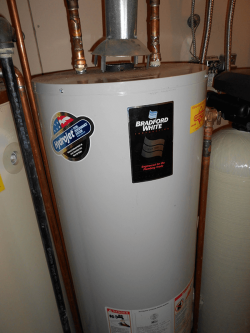Do You Need More Hot Water in Your Home?
Does your standard tank type water heater seem to run short of hot water on a regular basis? Is the temperature of your tank set near HOT, but there’s still not enough to go around? Has your family grown in size, and your standard 40 gallon tank no longer keeps up with demand? What can be done to solve this inconvenient, not uncommon situation?

What Options Should You Consider?
If you are serious about improving your hot water performance, review the following suggestions to see if any are consistent with your objectives, and then contact a professional plumbing and heating contractor to learn more:
- Tempering Valve: If your current water heater is fairly new, well insulated, and in good condition, adding a tempering valve (aka. mixing valve) to your water heater can soup up your hot water capacity. After the device is installed, the water temperature in the tank can be increased well above the normal setting. That hotter water is then blended when needed with cooler water outside the tank to yield a safe hot water temperature at the tap. The higher storage temperature, in essence, allows you more useable hot water. This is not a very common application, and won’t be the ideal solution in most cases.
- A bigger water heater: A 40-gallon, basic water heater was the new construction standard for many years, and this often did a serviceable job for most households. If you can’t get the kids out of the shower and find yourselves coming up short in hot water supply—but also wish to keep the budget as reasonable as possible—it might make sense to install a well-insulated, standard 50 gallon replacement water heater, with the highest BTU rating that will still work with your existing flue pipe. Make sure that the BTU input rating is at least as high as the tank you are replacing. And if your need for increased water supply is great enough, larger capacity tanks are also available.
- High Recovery Replacement Water Heaters: The speed with which your water heater heats up cold water for household use is referred to as the recovery rate of the heater, which is measured in gallons-per-hour (gph). The higher the recovery number, the better. Replacing your tank with a high recovery model, in most cases, will provide only marginal increases in immediate hot water. However, it will also mean it takes less time for the tank to heat back up again. When looking at a high recovery unit, your contractor should ensure that the existing vent system will accommodate the exhaust needs of the new heater.
- Tankless Water Heaters: A great solution for increasing the hot water supply in your home—although typically carrying the highest price tag up front—is the tankless gas water heater. A properly sized, professionally installed tankless heater can provide a continuous stream of domestic hot water—all of it supplied on-demand, as you need it. No storage tank, no standing pilot, and in most cases, quite compact and anchored to a wall in your mechanical room. Because there is no hot water storage, the efficiency of these units is through the roof. The tankless route is a major change in parameters and your installation contractor should heed the manufacturer specifications reqarding gas supply piping and flue pipe installation. So if you go the tankless route, choosing a professional installer is critical.
- Sidearm Tanks for Hydronic Heat Systems: If your home is heated by a hot water boiler (hot water baseboard or radiant floor heat), another option worth considering is an indirect-fired water heater, or sidearm tank. Operating as a separate zone off your boiler, a sidearm tank provides hot water at the same efficiency level as your boiler, which is typically more efficient than a conventional water heater.In addition, because the boiler typically has a large BTU capacity in order to heat your home, it can quickly re-heat the tank. Since there is no direct heat source, it operates in a low-stress environment for a long service life. An indirect fired water heater will typically provide quite a bit more hot water than a conventional gas heater of comparable size.
If hot water is in short supply in your home, first stop and consider what you can do to help yourself. If a new water heater appears to be in the cards, take the time to learn about your options. Consult a reputable plumbing and heating contractor, to obtain professional recommendations and firm quotes. Then make an educated decision that you’ll be able to live comfortably with for years to come!




